小学三年级英语下册语法知识解读
- 格式:doc
- 大小:30.50 KB
- 文档页数:4
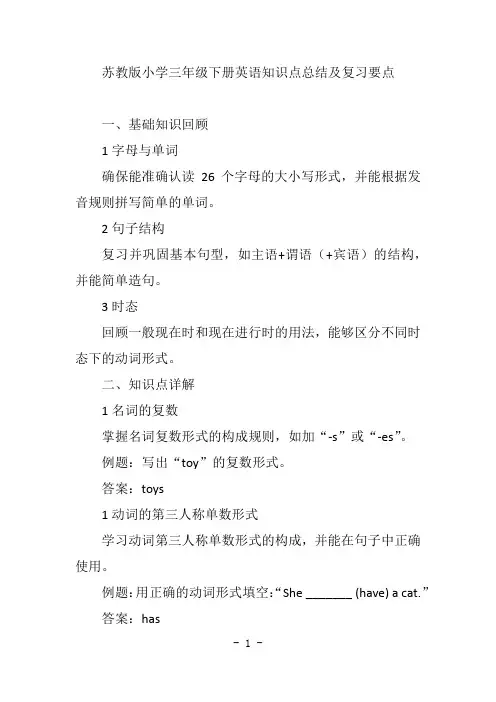
苏教版小学三年级下册英语知识点总结及复习要点一、基础知识回顾1字母与单词确保能准确认读26个字母的大小写形式,并能根据发音规则拼写简单的单词。
2句子结构复习并巩固基本句型,如主语+谓语(+宾语)的结构,并能简单造句。
3时态回顾一般现在时和现在进行时的用法,能够区分不同时态下的动词形式。
二、知识点详解1名词的复数掌握名词复数形式的构成规则,如加“-s”或“-es”。
例题:写出“toy”的复数形式。
答案:toys1动词的第三人称单数形式学习动词第三人称单数形式的构成,并能在句子中正确使用。
例题:用正确的动词形式填空:“She _______ (have) a cat.”答案:has3介词的使用复习介词的用法,如表示位置、方向、时间等,并能根据语境选择合适的介词。
例题:用介词填空:“The ball is _______ the box.”答案:in4形容词与副词的比较级学习形容词与副词比较级的构成和用法,如“-er”形式的构成。
例题:比较两个事物:“My brother is _______ than me.”答案:taller5一般现在时与现在进行时的区分掌握两种时态的区别和用法,能在不同情境下选择正确的时态。
例题:选择正确的时态填空:“I _______ (watch) TV now.”答案:am watching(现在进行时)三、方法与技巧1记忆方法使用联想记忆法,将新单词与已知的事物或图像联系起来,便于记忆。
运用词根词缀法,通过了解单词的构成部分来记忆单词。
2阅读技巧学习略读和寻读技巧,快速定位并获取文章中的关键信息。
培养理解上下文的能力,根据上下文推测词义。
3听力技巧练习听懂不同语速和口音的英语,提高听力理解能力。
学会抓住关键词和关键信息,提高听力答题的准确率。
4口语练习多与同伴或老师进行对话练习,提高口语表达和交流能力。
模仿英语母语者的发音和语调,提高语音的准确性。
四、例题解析1选择题Example: —What do you do _______ the weekend?—I often play football.A. inB. onC. atAnswer: B2填空题Example: My favourite _______ is red.Answer: colour3改错题Example: She have a cat. (改正错误)Corrected: She has a cat.4连词成句Example: are, you, what, doing (?)Answer: What are you doing?五、复习要点定期复习制定复习计划,每周或每两周复习一次已学知识点,确保记忆牢固。
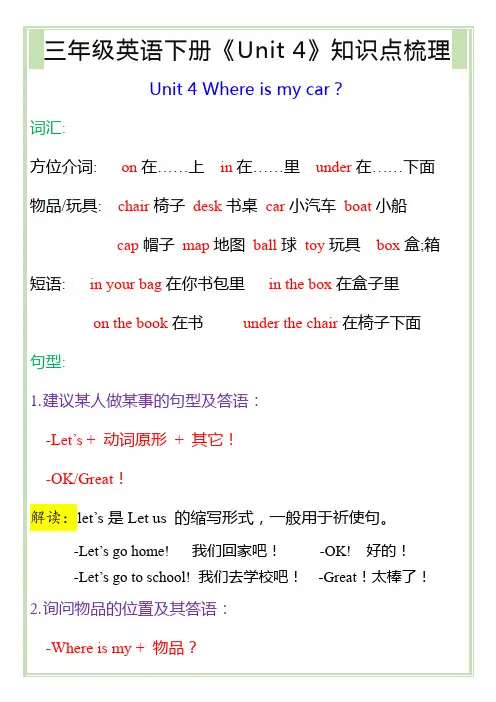
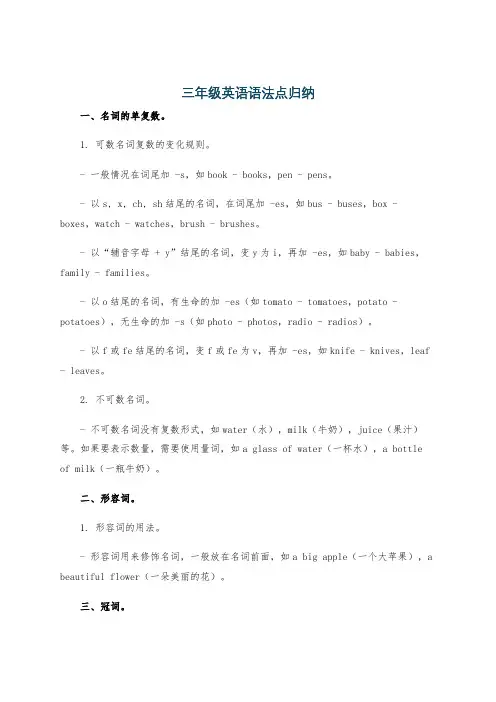
三年级英语语法点归纳一、名词的单复数。
1. 可数名词复数的变化规则。
- 一般情况在词尾加 -s,如book - books,pen - pens。
- 以s, x, ch, sh结尾的名词,在词尾加 -es,如bus - buses,box - boxes,watch - watches,brush - brushes。
- 以“辅音字母 + y”结尾的名词,变y为i,再加 -es,如baby - babies,family - families。
- 以o结尾的名词,有生命的加 -es(如tomato - tomatoes,potato - potatoes),无生命的加 -s(如photo - photos,radio - radios)。
- 以f或fe结尾的名词,变f或fe为v,再加 -es,如knife - knives,leaf - leaves。
2. 不可数名词。
- 不可数名词没有复数形式,如water(水),milk(牛奶),juice(果汁)等。
如果要表示数量,需要使用量词,如a glass of water(一杯水),a bottle of milk(一瓶牛奶)。
二、形容词。
1. 形容词的用法。
- 形容词用来修饰名词,一般放在名词前面,如a big apple(一个大苹果),a beautiful flower(一朵美丽的花)。
三、冠词。
1. a和an的用法。
- a用于以辅音音素开头的单词前,如a dog,a book。
- an用于以元音音素开头的单词前,如an apple,an egg。
2. the的用法。
- 表示特指,如The book on the desk is mine.(桌子上的那本书是我的。
)- 第二次提到某人或某物时用the,如I have a pen. The pen is red.(我有一支笔。
这支笔是红色的。
)四、代词。
1. 人称代词。
- 主格:I(我),you(你/你们),he(他),she(她),it(它),we(我们),they(他们/她们/它们)。
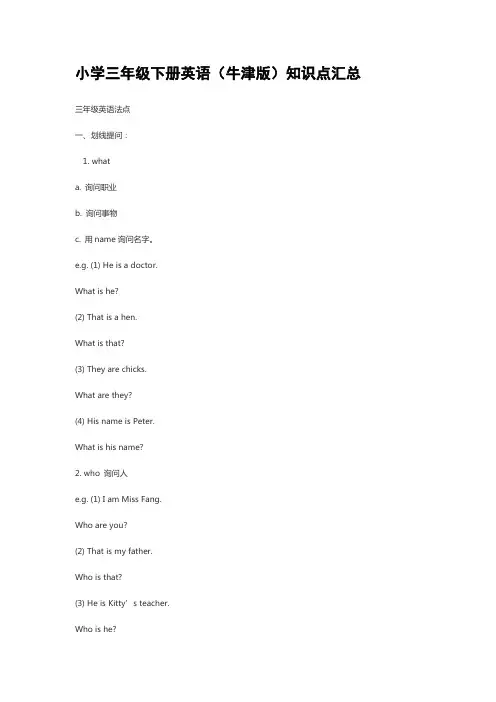
小学三年级下册英语(牛津版)知识点汇总三年级英语法点一、划线提问:1. whata. 询问职业b. 询问事物c. 用name询问名字。
e.g. (1) He is a doctor.What is he?(2) That is a hen.What is that?(3) They are chicks.What are they?(4) His name is Peter.What is his name?2. who 询问人e.g. (1) I am Miss Fang.Who are you?(2) That is my father.Who is that?(3) He is Kitty’s teacher.Who is he?3. what colour 询问颜色(1) This bag is blue.What colour is this bag? (2) They are yellow.What colour are they?4. howa. 询问身体状况b. 形容词(1) I’m fine. How are you?(2) He’s sad. How is he?5. how old 询问年龄(1) I’m nine.How old are you?(2) My sister is ten.How old is your sister?6. how many 问多少东西(1) Ten apples.How many apples?(2) One banana.How many bananas?7. how much 问多少钱(1) The apples are ten yuan.How much are the apples?(2) The pencil is one yuan.How much is the pencil?8. where 问地点The girls are in the park.Where are the girls?二、to be句型(一).否定句。

1. 介词“on…” “in…”的短语 on the chair/in the pencil-box/in the desk/in the bag/in the sky 2. 特殊疑问句“where”“what”“who”的⽤法 ①特殊疑问句“where”的⽤法: Where is …? ----It‟s on…. / It‟s in…. ②特殊疑问句“what”的⽤法: What‟s on the table? — A plate of cakes. ③特殊疑问句“who”的⽤法:. Who is he/she? He/ She is…. They are brother and sister. 当不知道是谁时,⼈称代词⽤it: Who is it? ----- It‟s me. 3. 感叹句⽤what和how: what修饰名词;how修饰形容词 How nice on a ship! How nice! What a fine day! What a big cake! 4.let’s 句型: let‟s =let us Let‟s make a blouse/vest. Let‟s run a race. /Let‟s play games. Let‟s ride it. Let‟s give her nice things. Let‟s sing“Happy Birthday to You”. Let‟s count the candles. Let me help you. Let me open/close the door. Let me get the apples/pears. Let‟s go home. 5. can句型: We can‟t let him in. She can’t swim. I can‟t find/see…. Can she swim? Yes, she can. / No, she can’t. Can you make cakes? Yes, I can. / No, I can‟t. Can you fly it? —Of course,I can. 6.主语是单数第三⼈称,谓语动词加“s”: look like 看起来像 She looks like Steve. Steve is Eve’s brother. I like him, and he likes me. 7.“have”的⽤法: ①“have”表⽰“有” I have a kite/ a new bike. We have some nice things for you. ②“have”表⽰“吃” Have a coke/an apple. —Yes, thank you./ No, thanks. Please have the cake. —Thank you. Let‟s have the good things.。
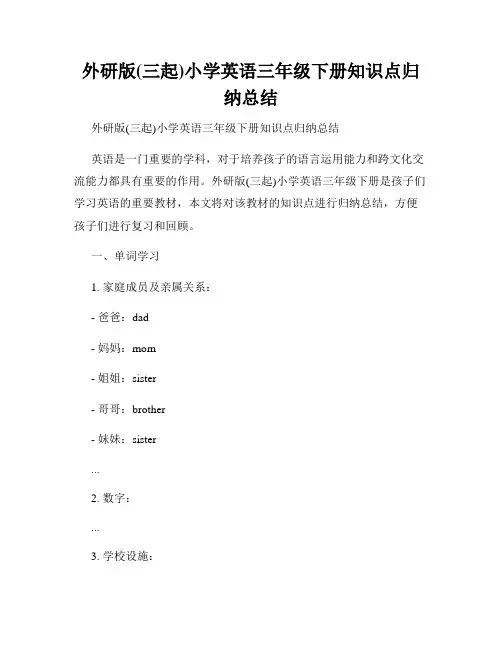
外研版(三起)小学英语三年级下册知识点归纳总结外研版(三起)小学英语三年级下册知识点归纳总结英语是一门重要的学科,对于培养孩子的语言运用能力和跨文化交流能力都具有重要的作用。
外研版(三起)小学英语三年级下册是孩子们学习英语的重要教材,本文将对该教材的知识点进行归纳总结,方便孩子们进行复习和回顾。
一、单词学习1. 家庭成员及亲属关系:- 爸爸:dad- 妈妈:mom- 姐姐:sister- 哥哥:brother- 妹妹:sister...2. 数字:...3. 学校设施:...4. 动物:...二、语法学习1. 句型- 主语+动词- 主语+be动词+形容词2. 疑问句- 一般疑问句:动词/动词短语+主语?- 特殊疑问句:疑问词+一般疑问句三、句子构成1. 基本句型- I am a student.- She is my sister.2. 特殊句型- What's your name?- How old are you?四、情境会话1. 问候与介绍- Hello, good morning/afternoon/evening.- What's your name?- My name is...2. 日常生活用语- Thank you/You're welcome.- See you later.五、阅读理解1. 阅读文章并回答问题- 根据文章内容回答问题。
六、综合练习1. 完成句子- 根据图片或提示补全句子。
2. 选择正确答案- 根据问题选择适当的答案。
以上是对外研版(三起)小学英语三年级下册的知识点进行的归纳总结,通过复习这些知识点,帮助孩子们巩固已学知识,提高英语表达能力和语言理解能力。
希望孩子们能够在学习英语的过程中不断进步!。
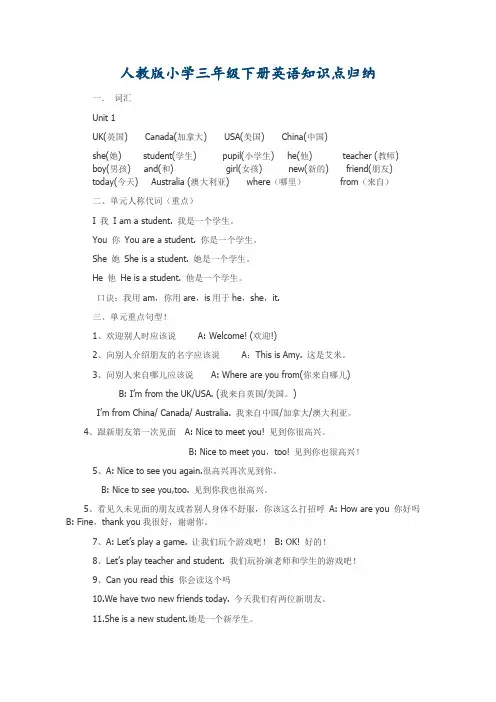
人教版小学三年级下册英语知识点归纳一.词汇Unit 1UK(英国) Canada(加拿大) USA(美国) China(中国)she(她) student(学生) pupil(小学生) he(他) teacher (教师)boy(男孩) and(和) girl(女孩) new(新的) friend(朋友)today(今天) Australia (澳大利亚) where(哪里)from(来自)二、单元人称代词(重点)I 我I am a student. 我是一个学生。
You 你You are a student. 你是一个学生。
She 她She is a student. 她是一个学生。
He 他He is a student. 他是一个学生。
口诀:我用am,你用are,is用于he,she,it.三、单元重点句型!1、欢迎别人时应该说A: Welcome! (欢迎!)2、向别人介绍朋友的名字应该说A:This is Amy. 这是艾米。
3、问别人来自哪儿应该说A: Where are you from(你来自哪儿)B: I’m from the UK/USA. (我来自英国/美国。
)I’m from China/ Canada/ Australia. 我来自中国/加拿大/澳大利亚。
4、跟新朋友第一次见面A: Nice to meet you! 见到你很高兴。
B: Nice to meet you,too! 见到你也很高兴!5、A: Nice to see you again.很高兴再次见到你。
B: Nice to see you,too. 见到你我也很高兴。
5、看见久未见面的朋友或者别人身体不舒服,你该这么打招呼A: How are you 你好吗B: Fine,thank you我很好,谢谢你。
7、A: Let’s play a game. 让我们玩个游戏吧!B: OK! 好的!8、Let’s play teacher and student. 我们玩扮演老师和学生的游戏吧!9、Can you read this 你会读这个吗10.We have two new friends today. 今天我们有两位新朋友。
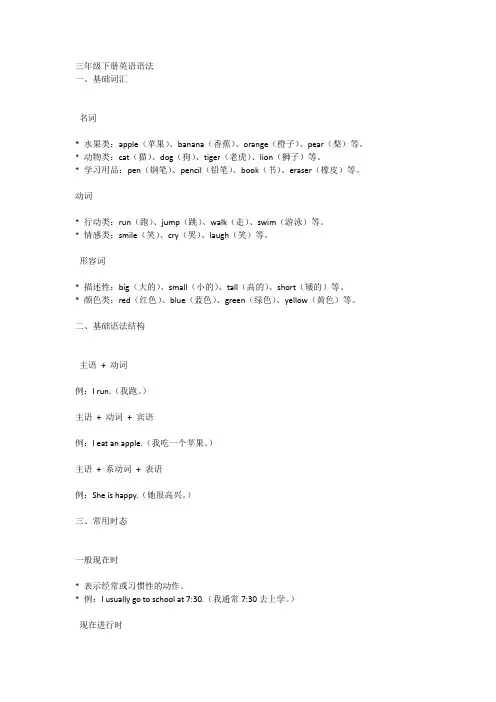
三年级下册英语语法一、基础词汇名词* 水果类:apple(苹果)、banana(香蕉)、orange(橙子)、pear(梨)等。
* 动物类:cat(猫)、dog(狗)、tiger(老虎)、lion(狮子)等。
* 学习用品:pen(钢笔)、pencil(铅笔)、book(书)、eraser(橡皮)等。
动词* 行动类:run(跑)、jump(跳)、walk(走)、swim(游泳)等。
* 情感类:smile(笑)、cry(哭)、laugh(笑)等。
形容词* 描述性:big(大的)、small(小的)、tall(高的)、short(矮的)等。
* 颜色类:red(红色)、blue(蓝色)、green(绿色)、yellow(黄色)等。
二、基础语法结构主语+ 动词例:I run.(我跑。
)主语+ 动词+ 宾语例:I eat an apple.(我吃一个苹果。
)主语+ 系动词+ 表语例:She is happy.(她很高兴。
)三、常用时态一般现在时* 表示经常或习惯性的动作。
* 例:I usually go to school at 7:30.(我通常7:30去上学。
)现在进行时* 表示正在进行的动作。
* 例:He is playing football now.(他现在正在踢足球。
)四、基础句型陈述句* 肯定句:主语+ 动词/系动词+ 其他。
* 否定句:主语+ 不/没+ 动词/系动词+ 其他。
疑问句* 一般疑问句:助动词/系动词+ 主语+ 动词/其他?* 特殊疑问句:疑问词+ 助动词/系动词+ 主语+ 动词/其他?感叹句* 表示强烈情感的句子,通常以what或how开头。
命令句* 表示命令或请求的句子,通常以动词原形开头。
五、常用短语和搭配* go to school(上学)* play football(踢足球)* have lunch(吃午饭)* watch TV(看电视)以上仅为三年级下册英语语法的基础内容,更详细的语法知识和实践练习,请结合教材和课堂教学进行。

英语三年级语法知识点总结英语三年级的学习内容对于学生来说是基础而关键的,语法知识点的掌握能够帮助学生更好地理解英语语言结构,提高语言运用能力。
以下是对三年级英语语法知识点的总结:名词的单复数- 学习名词的单数和复数形式,理解何时使用复数形式,如“cat”变为“cats”。
动词的时态- 重点学习现在时和过去时,如“run”变为“ran”,“eat”变为“ate”。
人称代词与物主代词- 区分并正确使用人称代词(如“I”, “you”, “he”, “she”)和物主代词(如“my”, “your”, “his”, “her”)。
形容词和副词的比较级和最高级- 学习形容词和副词的比较级(如“tall”变为“taller”)和最高级(如“tallest”)。
基本句型结构- 掌握陈述句、疑问句、祈使句和感叹句的基本结构。
介词的使用- 学习常用介词(如“in”, “on”, “at”)的用法,理解它们在句子中的作用。
冠词的使用- 理解定冠词“the”和不定冠词“a/an”的使用规则。
疑问词的用法- 学习如何使用疑问词(如“who”, “what”, “where”)来构建疑问句。
简单句和并列句- 学习如何使用并列连词(如“and”, “but”)将简单句连接成并列句。
一般疑问句和特殊疑问句- 掌握如何构造一般疑问句(以“yes”或“no”回答)和特殊疑问句(用疑问词开始)。
动词的第三人称单数- 学习动词在第三人称单数时的变化,如“he plays”中的“plays”。
现在进行时- 理解现在进行时的构成(be动词+动词的现在分词),如“he is playing”。
过去时和现在完成时- 学习过去时和现在完成时的构成和用法,理解它们在描述事件时的区别。
情态动词- 初步了解情态动词(如“can”, “may”, “must”)的用法。
非谓语动词- 学习动名词和不定式作为名词、形容词或副词的用法。
主谓一致- 理解主语和谓语动词在数上的一致性。
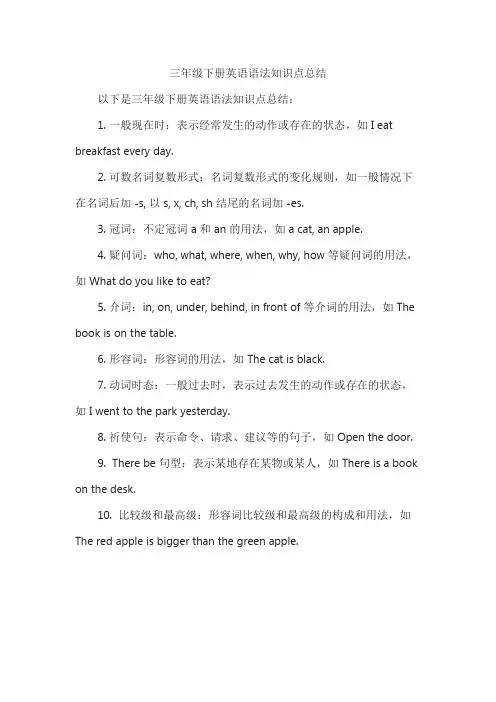
三年级下册英语语法知识点总结
以下是三年级下册英语语法知识点总结:
1. 一般现在时:表示经常发生的动作或存在的状态,如 I eat breakfast every day.
2. 可数名词复数形式:名词复数形式的变化规则,如一般情况下在名词后加 -s, 以 s, x, ch, sh 结尾的名词加 -es.
3. 冠词:不定冠词 a 和 an 的用法,如 a cat, an apple.
4. 疑问词:who, what, where, when, why, how 等疑问词的用法,如 What do you like to eat?
5. 介词:in, on, under, behind, in front of 等介词的用法,如 The book is on the table.
6. 形容词:形容词的用法,如 The cat is black.
7. 动词时态:一般过去时,表示过去发生的动作或存在的状态,如 I went to the park yesterday.
8. 祈使句:表示命令、请求、建议等的句子,如 Open the door.
9. There be 句型:表示某地存在某物或某人,如 There is a book on the desk.
10. 比较级和最高级:形容词比较级和最高级的构成和用法,如The red apple is bigger than the green apple.。

人教版PEP三年级下册基础知识汇总Unit 1 Welcome back to school !重点单词:[三会]UK (英国)USA (美国) Canada ( 加拿大) China (中国) he(他)she (她) teacher (老师) student (学生)[二会]boy(男孩)girl(女孩)and 和,与new 新的friend 朋友today今天重点句型●Welcome!欢迎!●Where are you from? 你来自哪里?●I'm from the UK.重点译文Part A Let’s talkBoys and girls,we have two new friends today.同学们今天我们有两名新同学。
Hi,I’’m from the UK.你好,我是艾米,我来自英国。
Hi,I'm Zhang Peng. I’m from Shandong.你好,我叫张鹏,我来自山东。
Welcome!欢迎!Part B Let’s talkMr Jones,this is Amy. She’s a new student.琼斯先生,这是艾米,她是新同学。
Where are you from?你来自哪里?I'm from the UK.我来自英国。
Part C Story timeLet's play a game!让我们玩个游戏!OK!好的。
Let's play teacher and student.让我们玩老师和学生的游戏。
’m the teacher.我长得大,我当老师。
I'm clever, I’m the teacher.我聪明,我当老师。
No,I’m the teacher.不,我是老师。
Wait a minute!等一会。
Can you read this?你会读这句话吗?Sure,“I'm the student.”当然可以“我是学生”。
新版译林小学英语三下知识点一、语法知识点:1. 一般现在时:表示现在经常性或习惯性的动作或状态,句子的主语为第三人称单数时,动词要加-s或-es。
2.一般过去时:表示过去发生的动作或存在的状态,动词过去式的构成规则。
3.现在进行时:表示现在正在进行的动作。
4. there be句型:表示处有物或人。
5.数词:基数词和序数词的用法。
6.名词复数形式:规则复数、不规则复数以及一些特殊名词的复数形式。
7.形容词比较级:表示两个人或事物之间的比较。
8.形容词最高级:表示三个或三个以上人或事物之间的最高级。
9.物主代词:表示所有关系。
10. 情态动词can的用法:表示能力、许可或请求。
11.人称代词的主格和宾格:主格用作主语,宾格用作宾语。
二、词汇知识点:1.人物、动物、植物等的名称。
2.数字、时间、日期等基本词汇。
3.季节、天气、颜色等基本词汇。
4.体育、娱乐、职业等基本词汇。
5.家庭成员、房间、家具等基本词汇。
6.学校、教室、学习用品等基本词汇。
7.食物、饮料、水果等基本词汇。
8.衣物、配件、颜色等基本词汇。
三、句型知识点:1. What's your/his/her name?:询问姓名。
2. How old are you/he/she?:询问年龄。
3. I/you/he/she/it/we/they am/is/are...:用于描述自己或他人的个人信息。
4. Do you like...? Yes, I do/No, I don't.:询问和表达喜欢或不喜欢的事物。
5. What color is it? It's...:询问和回答物品的颜色。
6. What's the weather like today?:询问今天天气如何。
7. What's your favorite...?:询问个人最喜欢的事物。
8. Can you...? Yes, I can/No, I can't.:询问和回答能力。
三年级语法知识点总结三年级的英语语法学习是基础中的基础,这个阶段的学习重点是帮助学生掌握一些基本的语法规则,为后续的学习打下坚实的基础。
以下是三年级英语语法的一些重要知识点总结:名词:- 单数名词和复数名词:学生需要了解名词的单数和复数形式,如何通过加“s”或“es”来形成复数。
- 名词所有格:学习如何使用撇号(')来表示所有关系,例如“my book”(我的书)。
动词:- 动词的时态:开始接触动词的现在时和过去时,了解动词在不同时态下的变化。
- 助动词:学习使用助动词“do”和“does”来构成疑问句和否定句。
形容词:- 形容词的比较级和最高级:学习如何使用“-er”和“-est”来形成形容词的比较级和最高级,例如“taller”和“tallest”。
副词:- 副词的比较级和最高级:了解副词的比较级和最高级,例如“faster”和“fastest”。
冠词:- 定冠词“the”和不定冠词“a/an”的使用:学习在什么情况下使用“the”,什么情况下使用“a/an”。
代词:- 人称代词:学习主格和宾格代词,如“I”和“me”,“he”和“him”。
- 所有格代词:学习如何使用“my”,“your”,“his”,“her”等来表示所有关系。
疑问句:- 学习如何构造一般疑问句,并理解回答“yes”或“no”的规则。
否定句:- 学习如何构造否定句,理解“not”在句中的位置和作用。
基本句型:- 学习基本的陈述句、疑问句和命令句的结构。
连词:- 学习如何使用简单的连词,如“and”,“but”,“or”来连接句子。
介词:- 学习基本的介词,如“in”,“on”,“at”,“under”,“over”等,并理解它们在句中的作用。
通过这些知识点的学习,三年级的学生将能够构建更复杂的句子,更准确地表达自己的想法。
同时,这也为学生日后学习更高级的语法知识打下了基础。
记住,语法学习是一个循序渐进的过程,需要不断的练习和应用。
闽教版小学英语根底语法三年级下册Unit 1 BirthdayPlease come to my birthday party. 请大家来参与我的生日派对。
Let’s buy a present. 〔Let’s buy a present for Sally.〕〔让〕我们去买个礼物吧。
And a birthday card. 还要买一张生日贺卡。
What about a football? 买一个足球怎么样?-- Oh, no! / Good ideal. 哦,不行!/ 好方法!Happy birthday, Sally! 生日欢快,莎莉!Here’s a present for you. 送你一个礼物。
What’s this? A bird? 这是什么?一只鸟?Oh! It’s a rabbit. Thank you. 哦!是一只兔子。
感谢你们。
Where’s the cat? -- In the hat.猫在哪里?-- 在帽子里。
祈使句:用来发出命令或是提出恳求和建议,谓语动词必需用原形,句子没有主语。
第一人称祈使句:以let为引导词Let’s buy a present. = Let us buy a present for Sally.〔让〕我们去买个礼物吧。
其次人称祈使句:以听话人为祈使对象,祈使对象you 通常不表示出来,句子以动词祈使式开头。
加please 是为了使句子口气缓和一些。
Please come to my birthday party. 请大家来参与我的生日派对。
What about〔……怎么样〕,what 引导的特别疑问句,询问某人、某物的状况或提出建议。
What about a football? 买一个足球怎么样?-- Oh, no! / Good ideal. 哦,不行!/ 好方法!完全倒装:句子中的谓语动词全部置于主语之前,常见的有here、there、now、then等副词置于句首,谓语动词常用be、come、go、run等。
人教版三年级英语下册语法知识点归纳对于英语的学习,其实需要学学生好好去掌握的就是两个点,第一个点是单词量的掌握,可以说词汇量越多越好.第二个点是语法知识的掌握,是重点也是难点.下面给大家带来一些关于人教版三年级英语下册语法知识,希望对你们有所帮助.三年级下册英语课本语法Unit1 Welcome back to school【词汇】UK 英国 Canada 加拿大 USA 美国 China 中国 she 她 student 学生 pupil 小学生 he他 teacher教师boy 男孩 and和;与 girl女孩 new新的 friend朋友 today今天【句型】1. Welcome! 欢迎! Welcome back! 欢迎回来!2. Nice to see you again. 再见到你很高兴.Nice to see you ,too. 见到你也很高兴.3. Where are you from? 你来自哪里?I m from the UK/USA. 我来自英国/美国.I m from China/Canada.我来自中国/加拿大4. We have two new friends today. 今天我们有两位新朋友.5. This is Amy.She is a student. 这是埃米,她是个学生.6. This is MR Jones. He is a teacher. 这是琼斯先生,他是一位教师.Unit2 My family【词汇】father父亲;爸爸 dad (口语) 爸爸;爹爹 man男人 woman 女人mother母亲;妈妈 sister 姐;妹 brother 兄;弟grandmother(外)祖母grandma (口语)(外)祖母grandfather(外)祖父grandpa(口语)(外)祖父family家;家庭【句型】1. Who’s that man? He is my father. 那个男人是谁?他是我爸爸.2. Who’s that woman? She is my mother. 那个女人是谁?她是我妈妈.3. Who’s that boy? He is my brother. 那个男孩是谁?他是我哥哥.4. Is she your mother? Yes,she is. 她是你妈妈吗?是的,她是.5. Is he your father? No,he isn’t. 他是你爸爸吗?不,他不是.6. He is my teacher. 他是我的老师.7. This my family. 这是我的家庭.Unit3 At the zoo【词汇】thin瘦的 fat胖的;肥的 tall高的 short短的;矮的long长的 big大的 small小的 giraffe长颈鹿so这么;那么 children(child的复数)儿童 tail尾巴【句型】1. Look at that giraffe. 看那只长颈鹿.2. It’s so tall. 它好高啊.3. It’s short and fat. 它又矮又胖.4. Come here,children. 到这里来.孩子们.5. It has a long nose. 它有个长鼻子.6. It has small eyes and big ears. 它有小眼睛和大耳朵.Unit4 Where is my car?【词汇】on在……上 in在……里 under在……下面 chair椅子 desk书桌 cap帽子ball球 car小汽车 boat小船 map地图toy玩具 bo_盒;箱【句型】1. Let’s go home! OK! 我们回家吧!好的!2. Where is my pencil bo_? 我的铅笔盒呢?3. Look!It’s in your desk. 看!它在你的书桌里.4. And your pencil! It’s under your book! 你的铅笔,它在你的书下面.5. Silly me! 我真傻!6. Where is my map? 我的地图在哪儿?7. Is it in your bag? No,it isn’t. 它在你的包里吗?不,它不在.8. Is it in your toy bo_? Yes,it is. 它在你的玩具箱里吗?是的,它在.9. Have a good time! 玩得开心点儿!Unit5 Do you like pears?【词汇】pear梨 apple苹果 orange橙子 banana香蕉 watermelon西瓜 strawberry 草莓 grape葡萄 buy买fruit水果【句型】1. Honey, let’s buy some fruit.宝贝儿,我们买点水果吧.2. Do you like oranges? Yes,I do/ No, I don’t.你喜欢橙子吗?是的,我喜欢/不,我不喜欢.3. Do you like pears? No,I don’t. I like apples.你喜欢梨吗?不,我不喜欢梨,我喜欢苹果.4. Have some grapes. Sorry,I don’t like grape.吃些葡萄吧.抱歉,我不喜欢葡萄.5. I don’t like watermelons. Me,neither.我不喜欢西瓜. 我也不喜欢.Unit6 How many?【词汇】eleven十一 twelve十二 thirteen十三 fourteen十四 fifteen十五si_teen十六 seventeen十七 eighteen十八 nineteen十九 twenty二十kite风筝 beautiful美丽的【句型】1. How many kites do you see? I see _. 你看到几只风筝.我看到十二只.2. Wow, so beautiful! 哇,真美丽啊.3. The black one is a bird. 黑色的那个是只鸟.4. How many crayons do you have? 你有多少支蜡笔?5. Open it and see. 打开看看!6. You have _ crayons. 你有十六支蜡笔.人教版三年级英语下册语法知识点归纳一.句型复习一般疑问句:Is this/that/it a ...? 回答:Yes,it is. No,it isn’t.Is he / she...? 回答:Yes, he /she is. No, he/she isn’t.Are you...? 回答:Yes, I am. No, I am not.Are these/they ...? 回答:Yes,they are. No,they aren’t.Do you...? 回答:Yes, I do. No, I don’t.Is there...? 回答:Yes,there is. No, there isn’t.Are there...? 回答:Yes,there are. No, there aren’t.特殊疑问句:Who’s he/she ? 回答:He’s/She’s ?Who are they? 回答:They are...Where is..? 回答:It’s in/on...(介词短语)Where are?? 回答:They are in/on...(介词短语) Where are you from? 回答:I am from.../ We are from...Where is he / she/ it from? 回答: He /She / It is from ? Where are they from?回答: They are from....What’s in / on / near/ under / beside the ?? 回答:There is /are ... How many...? 回答:There is one./There are two.(2个或2个以上的数字) What is it/this/that? (单数) 回答: It’s a... .What are they/these/those? (复数) 回答: They’re ...日常用语:Put...on/in(介词短语)... 回答: OK/All right.Draw... 回答: OK/All right.Thank you! 回答: You’re welcome.Here’s ... 回答:Thank you!二.名词单数变复数,一般都把s 加.特殊变化有以下:单数复数一个样, sheep--sheep fish- fish goldfish - goldfish Chinese-ChineseJapanese -Japanese2.遇到oo 变ee : foot-feet goose- geese tooth - teeth3.有些变化就是大:mouse – mice child - children man-men woman-women4 .以s, _, sh, ch 结尾 , +es (bus-buses, bo_-bo_es, brush-brushes, watch-watches)5.以0 结尾(有生命的o)+es (tomato-tomatoes)(番茄) 例外:kangaroo- kangaroos6.以辅音字母+y结尾,改y为i+es ( lady-ladies, baby-babies study-studies)7.以f 或fe结尾,改f或fe为v+es (knife- knives shelf-shelves)三.have与has 的区别:have, has 都是〝有〞,它们的用法有讲究, 表示〝某人有某物〞,have, has请记住. he, she, it〝有〞用has, I, we , they , you都用 have. 主人单数用 has , 主人复数用 have.have 就是能力强,疑问 ( ?)否定 (don’t / do not)都用它.四.have ,has 与there is , there are 的区别表示某人或某动物有 : has / have (I have a dog. The dog has a short tail.) 表示某地方有:there is / are (There is a book in the bag. )五.Some与any 的区别:some用于肯定句中,any用于否定句和疑问句中.如:I have some books. I don’t have any books. Do you have any books ?六.a 与an 的区别一般来讲,元音字母(即a, e , i, o , u )开头的单词用an如: an apple an ear an American girl an Australian stamp an old man 七. There be 句型 (即 there is / there are )意思: 表示某地方有某人或某物原则:就近原则 (There be 句型中的be 动词用is 还是用are由最靠近它的第一个名词是单数还是复数决定.)如: There is a book and some pens on the desk. There are some pens and abook on the desk.八.不可数名词:juice chalk tissue (不可数名词没有复数形式)There is some chalk. There is some juice. There is some tissue. 九.’s所有格 :表示:某人或某动物的the girl’s name 那个女孩的名字 the teacher’s desk 讲台the headmaster’s office 校长的办公室 the children’s toys 儿孩子们的玩具the teachers’ room 教师办公室 (当名词的复数形式是以〝s〞结尾时,直接加’)十. be 动词 :is are am ( 表示〝是〞 )I 用am , you 用are , is 连着he,she ,it .单数名词用is ,复数名词全用are . 如: I am …. Youare… . We are… . They are…. . He is….. She is….. It is…. The girl is …. The boysare…. Ben is…. Janet and Ben are…人教版三年级英语下册语法知识点。
人教版三年级英语下册语法知识点总结语法知识点总结本文档旨在总结人教版三年级英语下册的语法知识点,以下是相关内容的概述:1. 时态(Tenses)- 现在时(Present Tense): 表示当前或经常性的动作或状态。
如:I eat an apple.- 过去时(Past Tense): 表示过去发生的动作或状态。
如:She played soccer yesterday.- 将来时(Future Tense): 表示将来要发生的动作或状态。
如:We will go to the park tomorrow.2. 动词(Verbs)- 动词是句子中的关键词,表示动作或状态。
如:read, run, sleep。
- 动词的原形、现在分词和过去分词的概念及构成规则。
- 动词的变化规则,如:第三人称单数加s或es,过去式用-ed 或变体形式。
3. 名词(Nouns)- 名词是表示人、事物、动物等的词。
如:book, cat, teacher。
- 可数名词和不可数名词的区别,以及它们的用法。
- 名词的单数形式和复数形式的构成规则。
4. 代词(Pronouns)- 代词是用来代替名词的词语。
如:he, she, it。
- 主格代词、宾格代词、物主代词和反身代词的概念及用法。
5. 冠词(Articles)- 冠词是用来修饰名词的词语。
如:a, an, the。
- 不定冠词(a/an)用法的规则和注意事项。
- 定冠词(the)用法的规则和注意事项。
6. 介词(Prepositions)- 介词是用来表示名词之间的关系的词语。
如:in, on, at。
- 常用介词的用法及注意事项。
以上是人教版三年级英语下册的语法知识点总结,希望对您有所帮助。
三年级英语十大语法知识点一、小学英语形容词性物主代词1、形容词性物主代词8个:My your his her its our your their我的你的他的她的它的我们的你们的他(她、它)们的2、形容词性物主代词的特点:1)译成汉语都有"的" eg:my 我的their 他们的2)后面加名词:eg:my backpack his name3)前后不用冠词 a an theThis is a my eraser(错误) That is your a pen(错误) It's his the pen(错误)3、I(物主代词)my you(物主代词)your he (物主代词)her we (物主代词) our 注:在变物主代词时,把原题所给的词加上的,再译成单词就可以了。
二、小学英语名词性物主代词1、名词性物主代词和形容词性物主代词一样有8个:Mine yours his hers its ours yours theirs我的你的他的她的它的我们的你们的他(她、它)们的2、名词性物主代词的特点:1)译成汉语都有"的" 2)后面不加名词3)名词性物主代词=形容词性物主代词+名词Eg:1、thepen is mine 钢笔是我的(mine=my pen)三、小学英语单数的句子变成复数的句子把单数的句子成复数的句子:变法是把能变成复数的词变成复数,但a或an要把去掉。
特殊疑问词、形容词、国家及地点通常不变。
Eg:把下列句子变成复数1, I have a car ----we have cars2, He is an American boy. ----They are American boys3, It is a car ----They are cars4, This is an eraser ----These are erasers5, That is a backpsck -----Those are backpacks6,I'm an English teather ------We are English teathers7,It's a new shirt---- They are new shirts8,He's a boy ----They are boys9,She's a singer ------They are singers10,What's this in English?---- What are these in English?四、小学英语名词的数语法名词有单数和复数两种形式1、名词的单数:表示一个人或一个事物2、名词的复数:表示一个人以上的人或事物名词复数的变化规律如下:1、多数情况下在名词后面加S,s 在清辅音后读【S】2、以s,x,sh,ch为结尾的词在词尾加es, es读作【iz】3、以f,fe为结尾的词去掉f或fe加ves,ves读作【vz】4、以辅音加y结尾的词,变y 为ies5、以元音加y结尾的词,直接加s6、不规则变化a变成eMan-menwoman-womenpoliceman-policemenPolicewoman-policewomen单复数同形Chinese-chineseJapanese-japanesesheep -sheepdeer -deer不规则变化This 这个these这些(复数)that那个those那些(复数)I我we我们(复数)he他she她it它they他、它、她们(复数)am ,is是are(复数)五、小学英语人称代词主格及宾格人称代词分为主格和宾格,主格和宾格区别:主格和宾格汉语意思相同,但位置不同。
小学三年级英语下册语法知识解读
1. 介词“on?”“in?”的短语
on the chair/in the pencil-box/in the desk/in the bag/in the sky
2. 特殊疑问句“where”“what”“who”的用法
①特殊疑问句“where”的用法:
Where is …? ----It?s on…. / It?s in….
②特殊疑问句“what”的用法:
What?s on the table? — A plate of cakes.
③特殊疑问句“who”的用法:.
Who is he/she? He/ She is….
They are brother and sister.
当不知道是谁时,人称代词用it:
Who is it? ----- It?s me.
3. 感叹句用what和how: what修饰名词;how修饰形容词
How nice on a ship! How nice!
What a fine day! What a big cake!
4.let’s 句型:
let?s =let us
Let?s make a blouse/vest.
Let?s run a race. /Let?s play games.
Let?s ride it.
Let?s give her nice things.
Let?s sing“Happy Birthday to You”.
Let?s count the candles.
Let me help you.
Let me open/close the door.
Let me get the apples/pears.
Let?s go home.
5. can句型:
We can?t let him in.
She can’t swim.
I can?t find/see….
Can she swim? Yes, she can. / No, she can’t.
Can you make cakes? Yes, I can. / No, I can?t.
Can you fly it? —Of course,I can.
6.主语是单数第三人称,谓语动词加“s”:
look like 看起来像
She looks like Steve.
Steve is Eve’s brother.
I like him, and he likes me.
7.“have”的用法:
①“have”表示“有”
I have a kite/ a new bike.
We have some nice things for you.
②“have”表示“吃”
Have a coke/an apple. —Yes, thank you./ No, thanks. Please have the cake. —Thank you.
Let?s have the good things.
备注说明,非正文,实际使用可删除如下部分。
本内容仅给予阅读编辑指点:
1、本文件由微软OFFICE办公软件编辑而成,同时支持WPS。
2、文件可重新编辑整理。
3、建议结合本公司和个人的实际情况进行修正编辑。
4、因编辑原因,部分文件文字有些微错误的,请自行修正,并不影响本文阅读。
Note: it is not the text. The following parts can be deleted for actual use. This content only gives reading and editing instructions:
1. This document is edited by Microsoft office office software and supports WPS.
2. The files can be edited and reorganized.
3. It is suggested to revise and edit according to the actual situation of the company and individuals.
4. Due to editing reasons, some minor errors in the text of some documents should be corrected by yourself, which does not affect the reading of this article.。